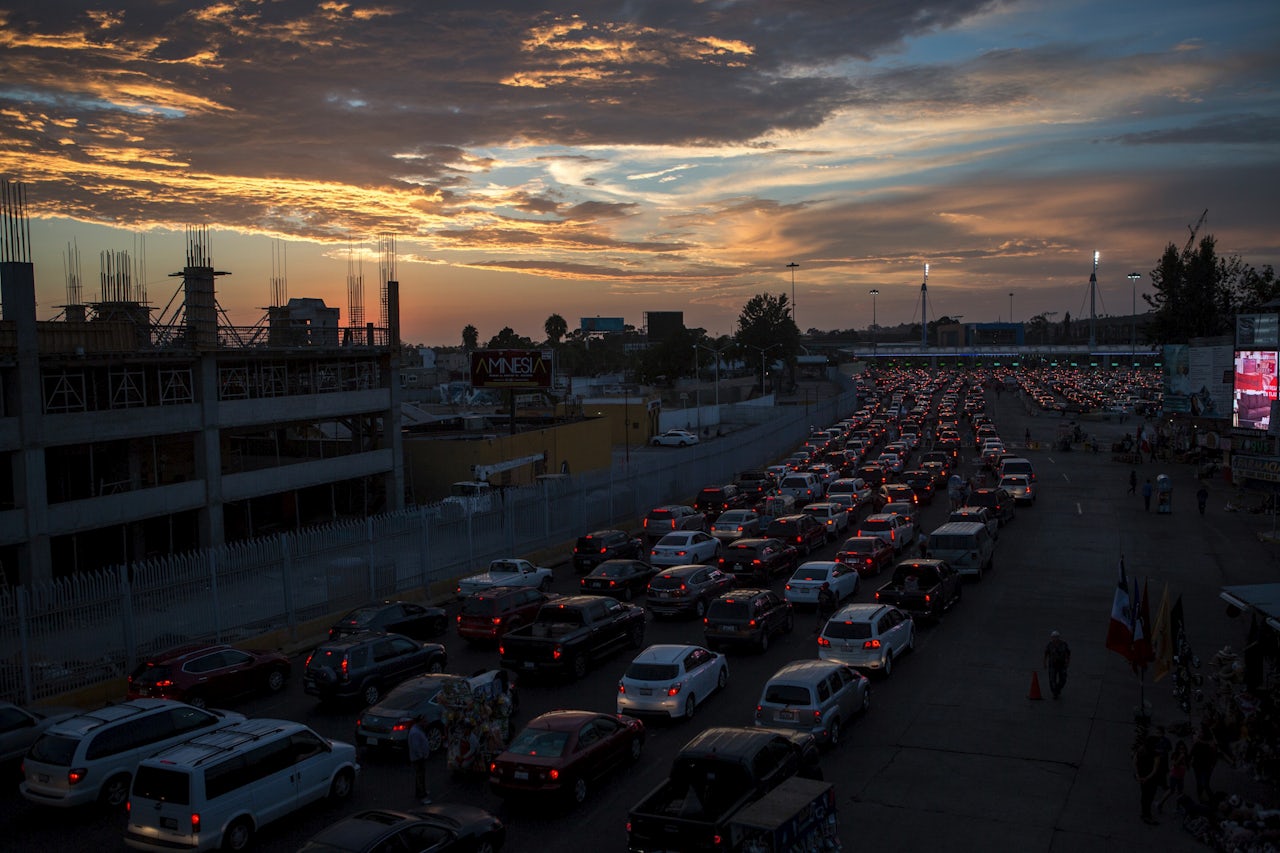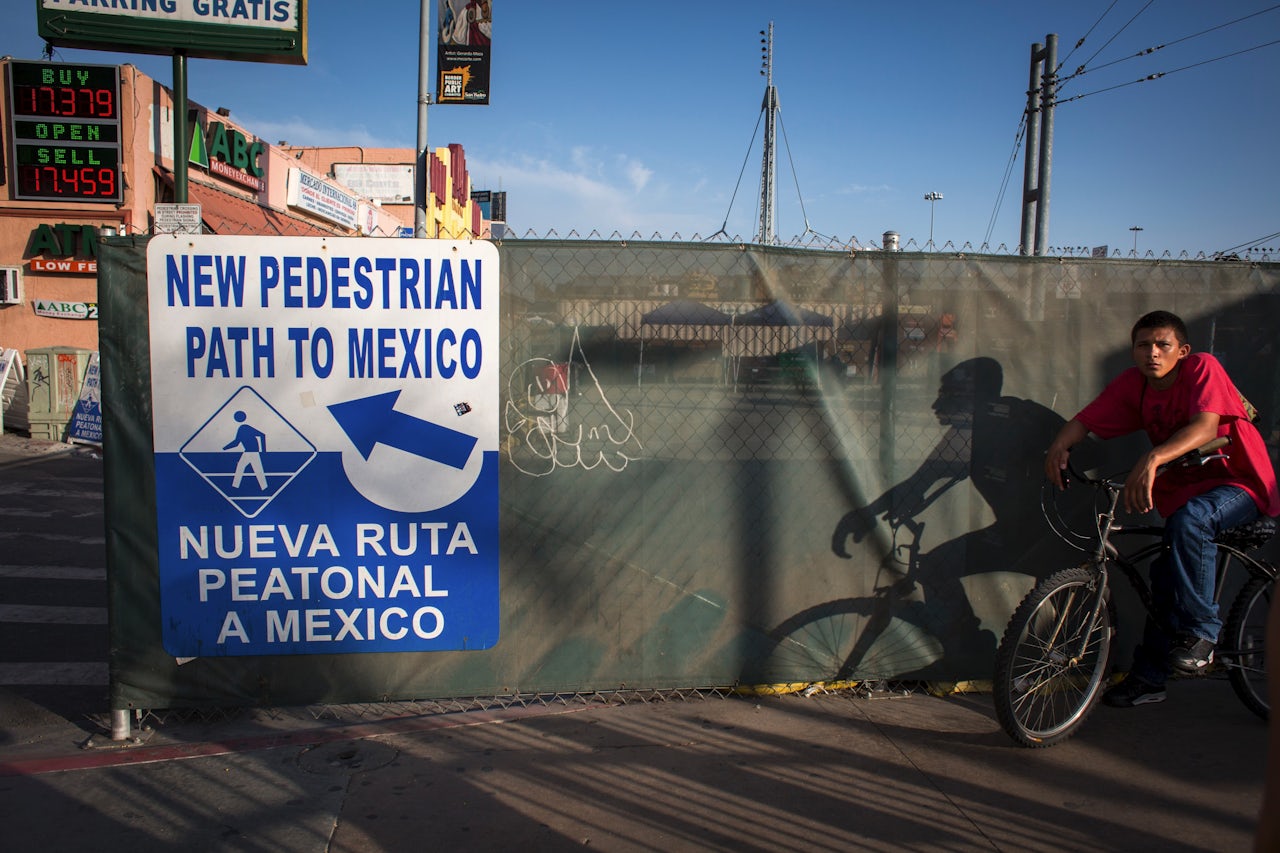On the Mexican side of San Ysidro Port of Entry on the border of California, traffic starts backing up long before the sun rises. Commuters shift their gears into park; lower their seatbacks for pre-dawn naps; buy Mexican grilled corn or burritos from street vendors; and listen to roving musicians strumming traditional norteño ballads — anything to help pass the time as they wait to enter the United States for the start of the American work day.
By the time that the traffic accumulates, Joaquin Harris, 37, a Mexican-American citizen born in San Diego but living in Tijuana, is long gone. Six days a week for the past 16 years, Harris has crossed the border at 3 a.m. for his 6 a.m. shift at a San Diego shipyard.
His schedule is common among Tijuana’s daily commuters, which include blue-collar workers, educated professionals, and students (both schoolchildren and college-aged), that cross by car and foot, a process that can take anywhere from a few minutes to a few hours.
The act of crossing is itself a privilege, one that an estimated 55 percent of Tijuanenses do not possess, according to a study by Tito Alegria, the Director of Urban and Environmental Studies at El Colegio de la Frontera Norte — and this figure does not include the migrants and American deportees that see Tijuana as a transit point. Increasingly, the would-be American immigrants are not Mexican, coming from Central America, Haiti, and even Asia. Meanwhile, 90,000 Mexicans have been deported in the first half of 2017, and of the 15 euphemistically named “repatriation centers,” Tijuana is the single most common destination.
For those that can cross, other privileges help determine their time in transit. U.S. and Mexican citizens and permanent residents can pay $155 to apply for the Secure Electronic Network for Travelers Rapid Inspection (SENTRI) program, a pre-approved accelerated crossing pass for low-risk travelers specific to the U.S.-Mexico border that cuts transit time significantly via dedicated vehicle and pedestrian lanes. Non-SENTRI-holders that have electronic Radio Frequency Identification chips in their documents, meanwhile, can take advantage of “Ready Lane,” which scans their identification from ten to fifteen feet away — sort of like an EZ-Pass for your travel documents.
But even for American citizens, SENTRI holders, and Ready Lane-eligible travelers, the wait can still be long and unpredictable.
Caitlin Trimble, an American citizen whose family moved from Los Angeles to Tijuana when she was ten, used to cross daily to attend college in San Diego. Her days would start at 4 a.m. so that she could be in San Ysidro by 5:15.
“For every 15 minutes that you arrived late, the border line was exponentially worse by a factor of three or four. You eat breakfast while standing in line because you can't afford to sit at a table for 10 minutes,” she told me. “I would take two buses, the trolley, and walk two or three miles in between to get to school …[and] repeat that all in the opposite direction at the end of the day.”
When it came time for Trimble to find a job after she graduated, she knew that she wanted to stay in Tijuana — though she didn’t want to continue her grueling commute — so she looked for remote work opportunities. These days, she works from home three days a week as a paralegal for a San Diego law firm, traveling into the office on Tuesdays and Thursdays after the rush hour ends.
Ale Uzarraga, a Mexican-American photographer who commutes daily to her job in Chula Vista, California, still feels nervous at the border checkpoints, despite her dual citizenship and SENTRI pass. She typically moves quickly, but even so, she always budgets an hour at the crossing, just in case, using the time to put on makeup before work, one of her many so-called border-hacks. Explaining the concept, she says, “The border is not going anywhere. How can I make it work for me?”
Consuelo Ramos Quiñones, a Mexican lawyer who raised a transborder family between Chula Vista and Tijuana, commutes daily from Southern California, where she lives, to her family’s business in downtown Tijuana. For her, it’s the afternoon rush out of Mexico, rather than the morning commute, that is her biggest pain point.
Southbound traffic, from the U.S. into Mexico, is often let through without stopping, but day’s end on the northbound side is another story, when daily commuters are joined by day-trippers, medical tourists, and other casual visitors returning to the U.S. before dark.
“There are times when there are 300 to 400 vehicles,” Ramos Quiñones says. She calls the 700-7000 hotline to check on the wait time (local radio stations and Facebook groups also provide regular updates). When the line is too long, she detours through Otay Mesa, the next crossing point six miles to the east.
But many commuters, who have no choice but to cross at the busiest times of the day and night — between 3 and 6 a.m. and 4 and 7 p.m. — don’t bother to check. For them, spending pre-dawn and sunset hours at San Ysidro are part of the daily routine.
There are an estimated 350 million annual legal crossings on the U.S.-Mexico border, with San Ysidro as the busiest, with an average of 120,000 commuter vehicles, 6,000 trucks, and 63,000 pedestrians crossing daily.
A 2007 joint study by the San Diego Association of Governments and California Department of Transportation found that inefficiencies at entry points like San Ysidro cost $7.2 billion in lost economic output and 62,000 jobs on both sides of the “CaliBaja Binational Mega-Region,” as civic and business leaders have taken to calling the transborder metropolitan area.
The region is the most productive — and populous — along the U.S.-Mexico border, with 6.8 million people residing in CaliBaja, which encompasses San Diego and Imperial Counties and the state of Baja California, and a combined economic output of $220 billion. In comparison, the entire border, from east to west, has a population of 12 million.
According to the 2007 study, an extra 15 minutes of border wait time would result in an additional loss of $1 billion in productivity and 134,000 jobs every year. Notably, for “America-first” advocates, the cost is greater for the U.S., with $2 to $2.5 billion lost in San Diego, compared to $100 to 230 million in Tijuana.
This is something that a range of organizations, like the CaliBaja Mega-Region Initiative and the Smart Border Coalition, are looking to change. As several of the coalition’s leaders wrote in an op-ed in the San Diego Union Tribune earlier this year:
From a purely commercial perspective, our borders are America’s cash registers. All exports and imports must pass through them. No place else in the U.S., however, could make their customers wait in line every day for two hours and stay in business.
For Joaquin Harris, the decision to live Tijuana and work in California was a no-brainer: the U.S. offered a high-paying, stable job, while Mexico gave him an affordable and high quality of life.
Shipyard workers in San Diego, like Harris, earn between $17 and $26 per hour, according to Glassdoor. In comparison, a job in Tijuana’s maquiladora manufacturing industry, the city’s largest, pays between $2.85 to $4.60 per hour, according to the Tijuana Economic Development Corporation.
That’s not bad when considering Mexico’s countrywide minimum wage of 80 pesos per day (roughly $4.50), and median monthly salary of 13,239 pesos ($750), but it is low when compared to the U.S. — and California, in particular, where the $10.50 per hour minimum wage exceeds the federally mandated $7.25 per hour.
Trimble, the paralegal, also works north of the border for the higher pay. She would consider working in Tijuana, “if the price were right,” but by her own estimate, she makes three times the salary in San Diego than she would in Tijuana.
Not all commuters are northbound. Dr. Ariel Ortiz, a Mexican bariatric surgeon, drives south from his home in Coronado to the Obesity Control Center, a private weight-loss hospital that he runs, just a mile from San Ysidro on the Mexican side.
His clinic is part of Tijuana’s thriving medical tourism industry, which brings in an estimated one million patients a year for everything from basic check-ups and cancer treatments to cosmetic surgery. His clinic performs six to seven surgeries a day and has a three-month waiting list, with procedures starting at $6,500 (compared to more than $20,000 in the U.S.)
In Mexico, he doesn’t have to deal with convoluted American health insurance or a restrictive and “overburdening” Food and Drug Administration. Instead, Ortiz can pioneer — safely, he says, due to peer review — his weight-loss procedures up to four years before they are available in the U.S.
Ortiz is not alone, as U.S.-based entrepreneurs and investors are increasingly turning their interest, and capital, southwards. Michael Lenny and Daniel Altenburg, co-founders of ZipDev, a web and app development start-up, drive to Tijuana twice a week to work with their mostly Tijuana-based development team.
They take pride in being a binational company, which means more affordable technology for clients, mostly American small- and medium-size businesses, and access to a large pool of talented, English-speaking developers for them, all within the same time zone.
Meanwhile, for Ramos Quiñones, the lawyer in Chula Vista, Tijuana’s worsening violence is one reason that her permanent home is north of the border: “I do not feel very secure… but I can’t leave Tijuana because of my business.”
She is not alone in her concern; a public opinion poll conducted this year by the Metropolitan Center of Economic and Business Information found that 92 percent of Tijuanenses feel insecure in the city.
The numbers paint a grim picture. Drug-related violence in Tijuana, which peaked in 2009 and 2010, with 1,118 and 1,256 murders respectively, had gone down in recent years, but the numbers have been climbing since 2016, reflecting an increase in drug-related violence throughout Mexico. By early August of this year, Tijuana had seen some 950 murders, putting 2017 on track to be the city’s deadliest year on record.
And yet, there is far more to Tijuana than the drug wars. Ramos Quiñones, despite living on the other side, says that the uniqueness of life in CaliBaja is “not only because of the border — if you go to Juarez it’s very different— but because it is the most important border [area] of Mexico.”
Ale Uzarraga echoes this sentiment. “I miss the area when I travel. I miss that I can be in two countries at once.”
As the new section of Trump’s border wall begins construction this winter (assuming no further delays), CaliBaja’s transborder residents will continue their daily commutes.
“At first, there was a psychosis of fear,” says Ramos Quiñones of the early days of Trump’s presidency, “That they wouldn’t let you pass, that they’d take your documents. But now, we see that he ([Trump])’s busy with his own problems.”
After all, the ever-evolving region has undergone numerous other challenges and changes over the years. Here, on the U.S.-Mexican border, they’re accustomed to the wait.








